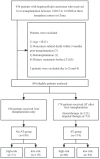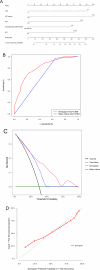Prognostic nomogram for recurrence of hepatocellular carcinoma after liver transplantation for decision making on postoperative adjuvant therapy
- PMID: 40702163
- PMCID: PMC12287375
- DOI: 10.1038/s41598-025-12178-1
Prognostic nomogram for recurrence of hepatocellular carcinoma after liver transplantation for decision making on postoperative adjuvant therapy
Abstract
It is well-documented that early recurrence of hepatocellular carcinoma following liver transplantation can markedly impact patient survival. Accurately identifying patients at risk for early recurrence, followed by timely interventions, could greatly improve the long-term efficacy of liver transplantation. The Milan criteria, the clinical gold standard for selecting patients with a low risk of post-transplant recurrence, fails to exclude high-risk patients with biologically aggressive hepatocellular carcinoma. Accordingly, there is an urgent need to develop and validate an improved model for predicting hepatocellular carcinoma post-liver transplantation. Herein, we established a new model to stratify the risk of early hepatocellular carcinoma recurrence following liver transplantation and facilitate decision-making regarding adjuvant therapy. Our newly established nomogram could predict early recurrence post-liver transplantation more effectively than the Milan criteria. Importantly, we found that adjuvant therapy could significantly benefit high-risk recipients but did not significantly affect low-risk recipients. Based on the new stratification criteria, adjuvant therapy should be actively considered for high-risk patients post-liver transplantation, whereas postoperative follow-up and observation are recommended for low-risk patients. Early recurrence of hepatocellular carcinoma (HCC) following liver transplantation (LT) can adversely affect long-term patient survival. The Milan criteria (MC) have limited capacity to predict early HCC recurrence, and no consensus regarding prophylactic adjuvant therapy (AT) after LT has been established. Herein, we developed an accurate model for predicting early HCC recurrence following LT to guide decision-making on AT. Overall, 364 patients with HCC from three transplantation centers in China were included and followed up for one-year post-LT. Baseline data were used to construct a nomogram, comparing performance with the MC. The efficacy of AT was compared between patients stratified into low- and high-risk subgroups based on nomogram scores.The nomogram included tumor burden score, alpha-fetoprotein level, platelet-to-lymphocyte ratio, pathological differentiation, and microvascular invasion as independent predictive factors. The concordance index and the area under the curve of the nomogram were 0·768 (95% confidence interval, 0·753-0·781) and 0·809, respectively, exceeding those of the MC. The results of the calibration curve and decision curve analysis were also satisfactory. Considering the high-risk subgroups, the AT group considerably outperformed the No-AT group in terms of 1-year recurrence-free survival (45·0 vs. 23·0%, P < 0·001). However, the low-risk AT and No-AT groups did not significantly differ (78·5 vs. 83·9%). In patients with HCC, the new nomogram predicted early recurrence post-LT more effectively than the MC. Based on the new stratification criteria, high-risk patients may benefit from AT, whereas AT is not recommended for low-risk patients.
Keywords: Adjuvant treatment; Early recurrence; Hepatocellular carcinoma; Liver transplantation; Nomogram.
© 2025. The Author(s).
Conflict of interest statement
Declarations. Conflict of interest: The authors declare no other conflicts of interest. Ethics approval: The authors are accountable for all aspects of the work in ensuring that questions related to the accuracy or integrity of any part of the work are appropriately investigated and resolved. The study was conducted in accordance with the Declaration of Helsinki (as revised in 2013). The study was approved by institutional ethics committees of the Shulan (Hangzhou) Hospital, The First Affiliated Hospital of the University of Science and Technology of China, and Huashan Hospital of Fudan University, and informed consent was waived by institutional ethics committees of the Shulan (Hangzhou) Hospital.
Figures



References
-
- Sung, H. et al. Global cancer statistics 2020: GLOBOCAN estimates of incidence and mortality worldwide for 36 cancers in 185 countries. CA Cancer J. Clin.71 (3), 209–249 (2021). - PubMed
-
- Torre, L. A. et al. Global cancer statistics, 2012. CA Cancer J. Clin.65 (2), 87–108 (2015). - PubMed
-
- Chen, W. et al. Cancer statistics in china, 2015. CA Cancer J. Clin.66 (2), 115–132 (2016). - PubMed
-
- Sapisochin, G. et al. Benefit of treating hepatocellular carcinoma recurrence after liver transplantation and analysis of prognostic factors for survival in a large Euro-American series. Ann. Surg. Oncol.22 (7), 2286–2294 (2015). - PubMed
MeSH terms
Grants and funding
LinkOut - more resources
Full Text Sources
Medical

